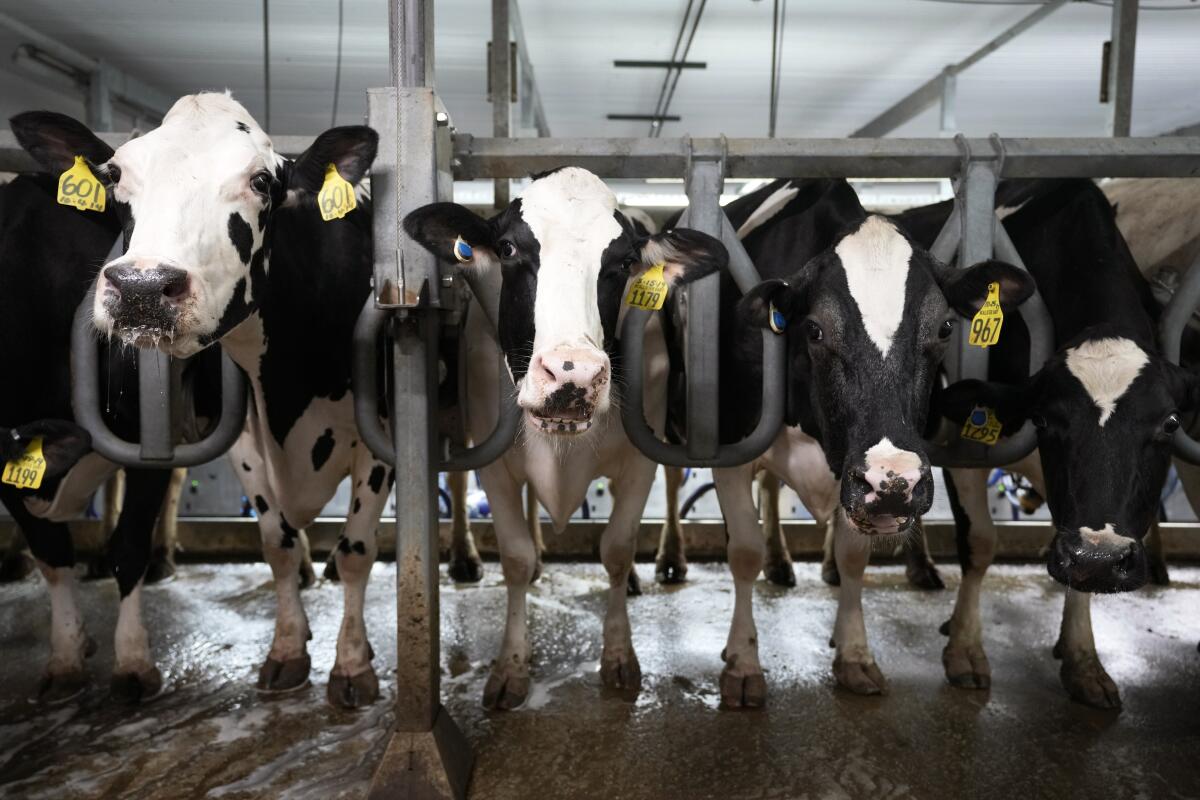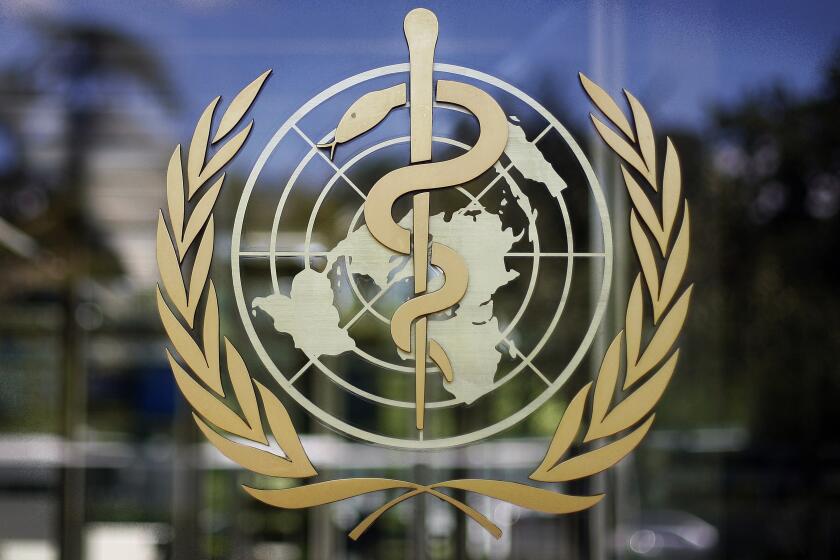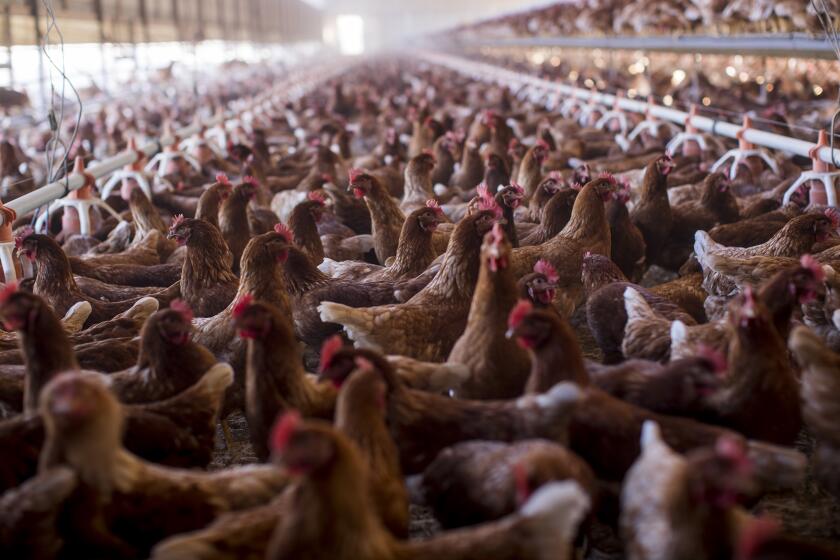Opinion: Bird flu is a real threat. Here’s a way to fight it

- Share via
If the last couple years are any indication, bird flu is not just for the birds.
Highly pathogenic avian influenza, also known as H5N1, has been confirmed in 101 dairy herds in 12 states since March, with Michigan, Texas and Idaho leading the pack. Even more troubling, there have been three confirmed human infections among U.S. dairy workers so far. Evidence of transmission from cows back to domestic and wild birds, and even to dairy farm cats, has also been found.
The first deadly human case of a subtype of bird flu has been confirmed in Mexico, the World Health Organization announced Wednesday.
Since early 2022, wild birds have shouldered the blame for the spread of the current iteration of H5N1 to domestic bird populations, ranging from backyard flocks to farms confining several million animals. Viral diseases commonly spread within the same or similar species. But alarm bells go off when they make the leap into species unrelated to the original host.
The latest spillover from birds to dairy cattle is particularly concerning because of the virus’ ability to spread undetected in cows that are in close contact with vulnerable dairy workers and produce meat and milk that may enter the food supply. The current strain of avian flu has infected at least 48 species of mammals worldwide, and recent reports indicate novel mammal-to-mammal transmission, including from cows directly to humans.
Officials still consider the threat to public health low. But even if the spread doesn’t escalate, it should be a warning to the federal government and the dairy industry.
Each year, millions of dairy cattle are transported long distances in the U.S. under grueling conditions — deprived of food, water and protection from extreme heat and cold. Transport stress additionally compromises animals’ immune systems. In particular, hundreds of thousands of newborn calves are transported on journeys that can exceed 1,000 miles. Male calves, typically considered a “low-value byproduct” of the dairy industry used for veal or beef production, are often fed unpasteurized waste milk, putting them at high risk of contracting H5N1, according to the U.S. Department of Agriculture.
News that Midwestern dairy cows may have become infected with avian flu by eating poultry waste has many asking: What are American farm animals being fed? And should we be concerned?
Livestock transport is regulated at the federal level by the Twenty-Eight Hour Law, which requires animals traveling domestically for more than 28 hours to be offloaded for food, water and rest, and the Animal Health Protection Act, which gives the USDA broad authority to restrict the movement of animals to control disease. Livestock transported across state lines must also comply with the receiving state’s import restrictions, which may require that the animals have certificates of veterinary inspection.
In theory, these laws act as important tools in protecting animal health and food safety. Unfortunately, enforcement of the Twenty-Eight Hour Law is virtually nonexistent, according to research conducted by my organization, the Animal Welfare Institute.
Additionally, neither the Twenty-Eight Hour Law nor the Animal Health Protection Act establishes specific requirements to ensure animals are both healthy and strong enough to travel. Although certificates of veterinary inspection can help trace the movement of infected animals during a disease outbreak, this system inevitably falls short. That’s because pre-transport assessments of animal health often amount to a quick visual inspection for outward signs of communicable disease instead of verification that animals can physically withstand the journey. Experts in humane livestock handling, including Temple Grandin, consider “fitness for transport” to be a crucial factor in protecting food safety and animal health and welfare.
Our warming world means billowing fires, breaking glaciers — and deadlier diseases.
Veterinary inspections are not even mandated for all transported animals, including many of the approximately 3 million “cull” dairy cows slaughtered annually. These animals often suffer from debilitating conditions that increase transport-related stress and immunosuppression. Meanwhile, of the more than 97 million U.S. birds affected by H5N1 since 2022, most have been killed to mitigate disease transmission. Many died horrifically after their owners induced heatstroke, according to USDA records.
This month, Rep. Dina Titus (D-Nev.) introduced federal legislation that would help address health and safety gaps. The Humane Transport of Farmed Animals Act would direct federal officials to develop a process to enforce the Twenty-Eight Hour Law, increasing active monitoring of long-distance transport. The bill would also prohibit interstate transport of livestock considered unfit for travel based on criteria from the World Organisation for Animal Health, the international authority on the health and welfare of animals.
New research suggests that a single H5N1 spillover event from birds to cattle occurred in Texas as early as last year. Subsequent cattle shipments carried the disease to distant herds around the nation. Stricter regulation may well have limited the spread.
When billions of animals are intensively raised, transported and slaughtered each year, conditions are ripe for pathogens to mutate, spread and seriously endanger animal and public health. The Humane Transport of Farmed Animals Act cannot stop the spread of bird flu on its own. But it would further essential efforts to provide oversight of the millions of animals — and their pathogens — regularly crossing state lines.
Gwendolen Reyes-Illg is a veterinary medicine consultant for the Animal Welfare Institute.
More to Read
A cure for the common opinion
Get thought-provoking perspectives with our weekly newsletter.
You may occasionally receive promotional content from the Los Angeles Times.













